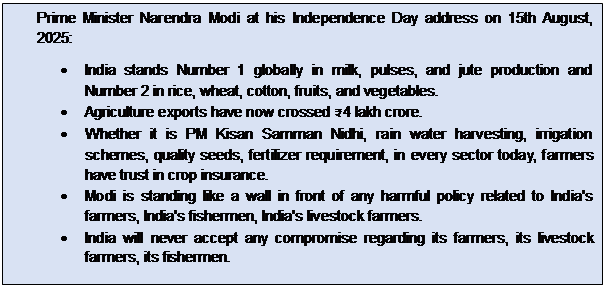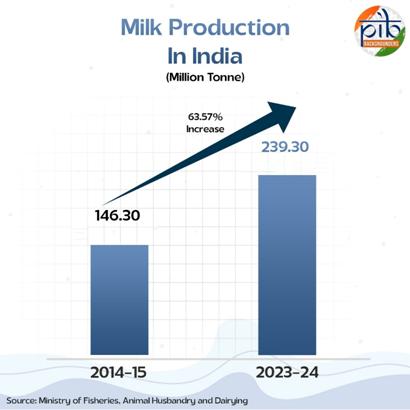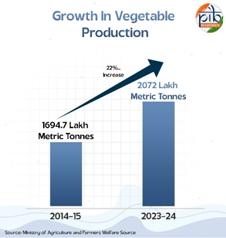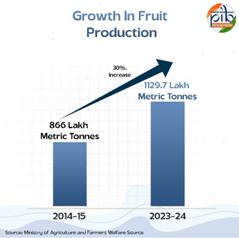Farmer's Welfare
Atmanirbharta in Agriculture Allied Sectors
प्रविष्टि तिथि:
15 AUG 2025 14:35 PM
“A Decade of Growth, Innovation and Farmer Empowerment”

Introduction
In agriculture, allied sectors—such as animal husbandry (dairy, poultry, goat and sheep rearing, piggery), fisheries and aquaculture (inland and marine), and horticulture (fruits, vegetables, flowers, spices, medicinal plants)—are closely linked to crop farming and play a vital role in diversifying rural incomes, reducing risks, and ensuring year-round livelihoods. By utilizing shared resources like land, water, and crop residues, these activities complement crop production, add value to the agricultural economy, and support millions of rural households. Less vulnerable to monsoon fluctuations, they are a key driver of resilience and rural growth, and under the Atmanirbhar Bharat vision, efforts focus on strengthening and modernizing these non-crop activities to reduce import dependency, boost rural incomes, enhance value addition, and ensure sustainable agricultural development.
Food Processing Sector
· As of July 2025, Agriculture and processed food exports reached approximately USD 49.4 billion in Financial Year 2024-25, with processed food exports constituting around 20.4%.
· The processed food export share has risen from 13.7% in 2014-15 to 20.4% in 2024-25.
Blue Revolution
- Fish production has grown by 104% from 96 lakh tonnes in 2013–14 to 195 lakh tonnes in 2024–25.
- Inland fisheries have expanded by 142% for the same period from 61 lakh tonnes to 147.37 lakh tonnes
- The Union Budget 2025-26, proposed the highest ever total annual budgetary support of Rs. 2,703.67 crores for the fisheries sector (increased by 3.3% from 2024-25 budget)
Dairy Sector
- India ranks 1st in the world in milk production, contributing 25% of global output. The sector has witnessed an average annual growth rate of 5.7%, significantly higher than the global average of 2%.
- Milk production in the country has increased by 63.57% over the last 10 years-from 146.30 million tonnes in 2014–15 to 239.30 million tonnes in 2023–24.
- Per capita milk availability in India has risen by 48%, reaching 471 grams/person/day in 2023–24, compared to the global average of 322 grams/person/day.
- The percentage of total milk production contributed by cows and buffaloes is 53.12% and 43.62%, respectively.
- Over 8 crore farmers employed in the dairy sector.
- Under the revised NPDD scheme, Department of Animal Husbandry and Dairying (DAHD) has approved State-wise targets for organization of 21,902 new dairy cooperative societies across the country during 2025-26
- Total approved financial outlay approved: ₹407.37 crore.
- Government of India’s share: ₹211.90 crore.
- Share of implementing organisations: ₹195.47 crore.
- As per state reports, about 1,804 dairy cooperative societies have been organised till date in 2025–26.
- These cooperatives have created employment opportunities for around 37,793 new milk producers.

- On March 19, 2025 Union Cabinet approved the Revised National Program for Dairy Development (NPDD) with a total outlay of ₹2,790 crore and the Revised Rashtriya Gokul Mission (RGM) with ₹3,400 crore for 2021–22 to 2025–26. These schemes aim to boost milk procurement, processing, and value addition, promote indigenous cattle breeding, strengthen the dairy supply chain, and enhance rural income and development.
National Beekeeping and Honey Mission (NBHM)
Launched in 2020 as part of the Atmanirbhar Bharat Abhiyan (Self-Reliant India Mission) with a total outlay of ₹500 crore for the period 2020–21 to 2022–23. The scheme has been extended for another three years, 2023–24 to 2025–26, with the remaining budget of ₹370 crore.
Key Achievements of NBHM:
- India produced 1.42 lakh metric tonnes of honey in 2022–23 and exported 79,929 metric tonnes.
- 167 women SHG activities supported for empowerment.
- With growing demand for beekeeping centres, a minimum export price of USD 2,000 per metric tonne has been imposed up to 31.12.2025.
- 6 world-class and 47 mini honey testing labs, along with 6 disease labs, have been set up.
- 8 custom hiring centres, 26 honey processing units, and other infrastructure have been built.
- Madhukranti Portal launched for online registration and traceability – over 14,800 beekeepers and 22.39 lakh colonies registered.
- 7 of 100 FPOs (Farmer Producer Organizations) for beekeepers formed under TRIFED, NAFED, and NDDB.
Horticulture
The horticulture sector has recorded impressive growth over the past decade. Fruit production rose from 866 lakh metric tonnes in 2014–15 to 1129.7 lakh metric tonnes in 2023–24, reflecting an increase of about 30%. Vegetable production also grew from 1694.7 lakh metric tonnes to 2072 lakh metric tonnes during the same period, marking a rise of 22%.


Ethanol Procurement
The Government is encouraging the blending of ethanol with petrol through the Ethanol Blended Petrol (EBP) Programme, under which Public Sector Oil Marketing Companies (OMCs) supply ethanol-blended petrol. This initiative not only supports clean energy but also provides a steady income source to sugarcane farmers by creating sustained demand for ethanol. The increase in ethanol prices and separate payment of GST and transport charges further strengthen farmer earnings. In the ongoing Ethanol Supply Year (ESY) 2024–25, OMCs have achieved an average ethanol blending level of 19.05% as of 31 July 2025. In July 2025 alone, the blending level reached 19.93%.
Over the past eleven years, from Ethanol Supply Year (ESY) 2014–15 to ESY 2024–25 up to July 2025, ethanol blending in petrol by Public Sector Oil Marketing Companies (OMCs) has led to foreign exchange savings of more than ₹1,44,087 crore. It has substituted about 245 lakh metric tonnes of crude oil, strengthening energy security, and has reduced CO₂ emissions by around 736 lakh metric tonnes -an environmental benefit comparable to planting 30 crore trees. At 20% blending, it is expected that payment to the farmers in this year alone will be to the tune of Rs.40,000 crore and forex savings will be around Rs. 43,000 crores.
Key Achievements
· Ethanol procurement rose from 38 crore litres in 2013–14 to 441crore litres in 2023–24.
· Rs. 1,11,703 crores paid to sugarcane farmers in Sugar Season 2023–24.
· 3% price hike in C-Heavy Molasses (CHM) ethanol to ensure better returns for farmers.
· Separate GST and transport charges directly benefit farmers’ earnings.
The programme is a major step towards doubling farmers' income, reducing dependence on crude oil imports, saving foreign exchange, and protecting the environment.
Pradhan Mantri Kisan Urja Suraksha Evam Utthan Mahabhiyan (PM-KUSUM)
The PM-KUSUM aims to reduce diesel use in agriculture and boost farmer income. It offers 30–50% central subsidy for installing standalone solar pumps and solarizing existing ones. Farmers can also set up solar plants up to 2 MW on barren land and sell power to DISCOMs. The scheme promotes clean energy and income generation, and is implemented by state government departments.
The PM-KUSUM scheme targets the addition of 34,800 MW of solar capacity by March 2026, with a total central financial support of ₹34,422 crore, which also covers service charges for the implementing agencies.
Achievements under PM-KUSUM Scheme
- Solar Pumps for farmers see a growth of over 92 times.
- 49 lakh agricultural pumps to be solarised under the scheme.
- Supports clean energy, reduces diesel dependence, and boosts farmer income.
References
PIB
https://www.pib.gov.in/PressReleasePage.aspx?PRID=2150877
https://www.pib.gov.in/PressReleasePage.aspx?PRID=2152462
https://www.pib.gov.in/PressReleasePage.aspx?PRID=2155110
https://www.pib.gov.in/PressReleasePage.aspx?PRID=2155558
https://www.pib.gov.in/PressNoteDetails.aspx?NoteId=154580&ModuleId=3
Lok Sabah
https://sansad.in/getFile/loksabhaquestions/annex/185/AU3905_0Fned9.pdf?source=pqals
Click here to download PDF
******
SK/SM
(Factsheet ID: 149246)
Visitor Counter : 2284
Provide suggestions / comments